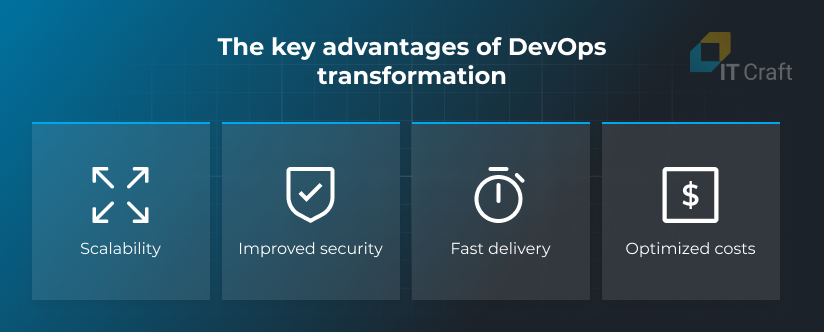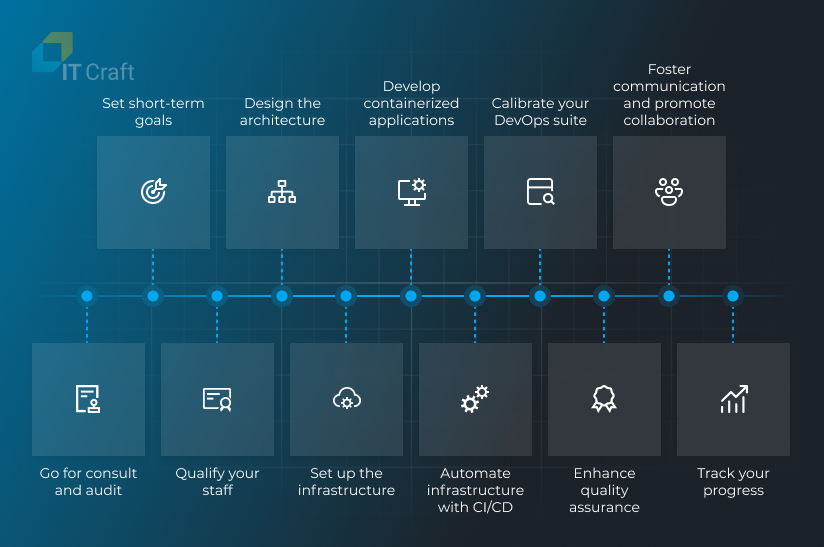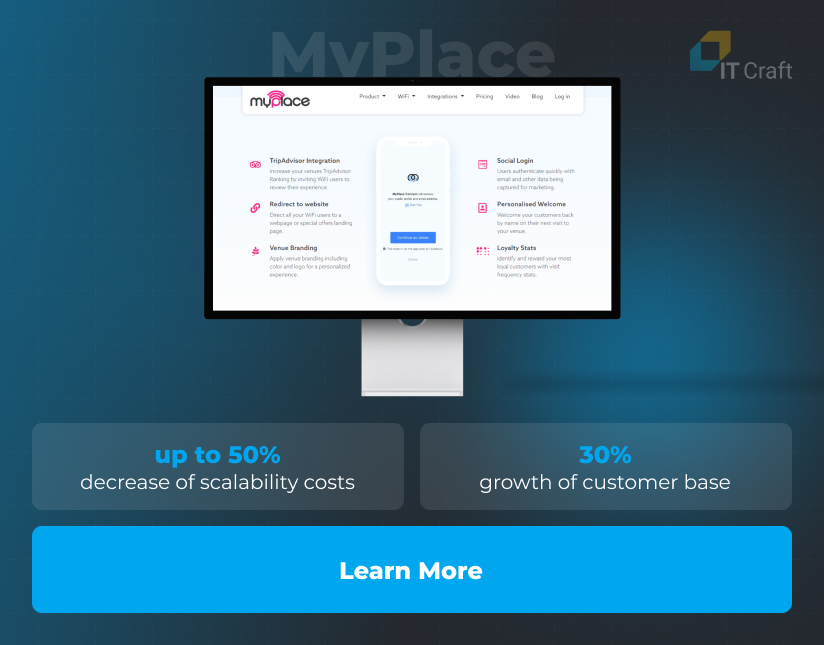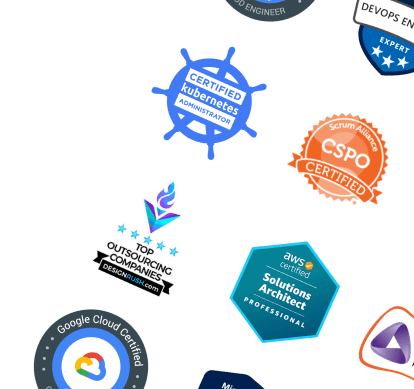The role of a well-thought-out DevOps transformation roadmap in the IT industry has been growing over the years. It allows companies to move to the cloud efficiently and cost-effectively, one of the key tech trends in various domains, including Real Estate, Healthcare, FinTech, Logistics, eCommerce, ERP, and many more.
Businesses ensure fast feature deliveries, scalability, improved security, and optimized operational costs by becoming cloud-native with the help of transformational DevOps services. For many, the most practical approach is DevOps outsourcing—a flexible way to bring in the right expertise without overloading internal teams.
A successful DevOps transformation strategy requires careful evaluation and handling, as it is the next big move. Below, let’s discuss the crucial steps and their relevance for a particular project.

1
What is DevOps Transformation?
Software development comprises two different departments: a developing team and an operations team. Opposite to traditional siloed development culture, the DevOps transformation roadmap is designed to automate and integrate interaction between development and operation teams.
This means that both teams constantly share their short-term outputs. Thus, they can continuously track product development progress and adjust required fixes quickly.
Using DevOps, businesses adapt faster to updates and development changes, deliver quickly, and execute consistent and smooth deployments.
Also, the DevOps implementation plan implies active cross-team communication, collaboration, and technology automation. By creating a generating culture with DevOps being an essential part of it, companies can achieve 30% higher performance. Learn more about how your business can adopt DevOps to unlock these advantages.
The core benefits of the DevOps transformation for projects are:
- Helps to create transparent relationships between teams
- Allows teams to deliver faster and perform better
- Significantly optimizes costs
- Implies internal and external feedback collection
- Improves mean time to detection and recovery
2
DevOps Transformation Steps

We have defined the importance of the DevOps practice to businesses. Now, let’s examine the DevOps transformation steps you should take to adjust your project.
Go for consult and audit
You establish a plan within this phase, considering the project’s goals and objectives. Consult third-party tech vendors with expertise to create a streamlined and achievable plan. Consulting is the optimal way to blueprint the DevOps transformation roadmap tailored to your organization and a cost estimate that lets you understand your budget needs.
Why?
First, DevOps engineers have a short tenure. According to Zippia’s statistics, 40% of DevOps engineers stay at a company for only 1 – 2 years, while 18% spend even less than a year, making replacement costs high.
Second, the DevOps workload can decrease drastically after the transformation is complete, forcing you to either pay an underutilized employee $125,000 – $135,000 annually or look for part-time/occasional cooperation, while a consultant can balance the workload.
External (i.e., third-party) tech providers can help with the matter efficiently. They have tech-savvy specialists who can perform an audit quickly and accurately. For the costs for an audit, you eliminate delays with feature shipments, understanding your next steps and related expenses.
Set short-term goals
Goals in a DevOps implementation plan should be measurable, challenging, and achievable. Most projects require a period of two to six months, but it can be longer based on the project’s specifications.
Within this timeline, every one or two weeks (sprint), track the progress of the transformation. One of the key advantages of such sprints is that they make it easier to change plans or priorities if necessary. Also, they reduce any delay between doing work and getting feedback by allowing them to adjust quickly.
Deployment frequency is one of the key metrics. Teams using DevOps practices ship source code 30 times faster and complete deployments up to 8,000 quicker than their old-fashioned competitors, resulting in improved time to market.
Qualify your staff
Before embedding a new organizational and technical workflow, find out if your team is ready for such a leap and eager to learn new skills and knowledge. The DevOps implementation plan embraces a wide range of novel infrastructure and methodologies available in the market. We’ll talk about the infrastructure a bit later.
There are three key approaches to the development methodologies:
Both infrastructure and methodologies get updated occasionally, so the team must be ready to learn on the go. Always. Keeping skills and knowledge up-to-date allows the DevOps teams to deliver products in unison with a fast-evolving technology market. Responding quickly to consumer demands is a crucial competitive advantage for any business domain.
Struggling to find tech-savvy specialists for your project?
Our experienced and certificated DevOps team can help you out. Let’s talk!
Contact us
Design the architecture
Architecture is the foundation of any project. Once you pick a DevOps transformation roadmap for your project, work patiently on its architecture. The architecture defines the project’s functional, non-functional, technical, and operational requirements.
The architecture pattern allows you to ascertain the best tech stack for your project. Everything should be accurately written down and contained in technical documentation.
Writing comprehensive technical documentation requires meticulous work. It’s a must-have element for a structured and organized workflow.
And it saves you and your teammates time: no need to explain the essence and details of the project to newcomers.
An intelligent architecture delivers product quality attributes such as maintainability, interoperability, security, and performance.
Set up the infrastructure
Now, with all the requirements on the table, it’s time for you to incorporate technical capabilities to release your project. DevOps transformation relies heavily on cloud technology for this purpose. You can save considerable costs by avoiding purchasing hardware servers and renting (or purchasing) permissions for them.
The key advantages of using cloud servers are:
- Increased server uptime
- Scalability of server resources
- Location independence
- Latest technology
- Fast set up (plug-and-play approach)
- Enhanced security
- Blazingly fast speed and performance of your website
- Backup and disaster recovery
Cloud servers work perfectly for the vast majority of projects. However, there can be situations when a project is required to use on-premises servers. Even so, you can benefit from DevOps transformation. There are tech vendors that provide services of remote on-premises server maintenance.
Develop containerized applications
Your DevOps transformation journey should include containerized applications. It’s an approach to software development when an application or service, its dependencies, and configurations (deployment manifest file) are packaged into an image of a container. Containerization allows IT specialists to deploy software in different environments without any amendments. You might hear of Kubernetes and Docker, which are services to work with containers. There is even a term, “Dockerizing,” meaning packing, deploying, and running applications using Docker containers.
Containers isolate applications from each other within a single operational system. You can package different versions of your product in separate containers. It’s very convenient to track the differences between them when needed. As a rule, all containers are created under open container standards. Thus, you can work with them via major software distributors like Linux, Microsoft, macOS.
This approach ensures robust safety during the development process. Since all containers are isolated, an amendment, update, or deletion of one of them does not affect another. Containers fit best with microservices architecture rather than a monolithic one.
Speaking of microservices, this architecture is also preferable in your DevOps practice. This type of architecture provides businesses with such advantages as:
- Scalability
- Easy-to-add features
- Better fault isolation
- Easier maintainability
- Versatility — better adaptability
- Easier to test components & simplified security monitoring
- Reusability
- Continuous delivery
- Easy integration
Automate infrastructure with CI/CD
One of the key activities in a DevOps implementation plan, CI/CD, relies on automation to reduce human factors that carry risks and bottlenecks in releasing and improving the software. This minimizes both development costs and time.
For instance, a medium-performing organization with 250 people onboard can save $2.8M to $4.7M in staff hours, according to DORA’s estimate. It can reinvest these hours into productive work such as delivering new functionality.
CI/CD infinity loop describes the workflow of this practice:

Code. Developers write the code.
Build. The code gets built (e.g., by the Jenkins system) or compiled together.
Test. After a successful pass of automated tests, the code is conveyed to manual testing. Once all tests are green ticked, you have a stable product version.
Release. You assign a serial number to the version, and it’s called a release candidate version.
Deploy. The release candidate versions are deployed in a production environment where it’s used by end users.
Operate. The operations team performs such actions as configuring servers and provisioning them with the required resources.
Monitor. You identify the health of the product and detect specific issues. Also, you collect feedback from users.
Plan. You’re about to plan improvements, and the collected feedback can help with that.
The most common technologies (tools) for building a CI/CD pipeline and implementing required DevOps transformations are:

Calibrate your DevOps suite
Adjusting a DevOps implementation plan to the realities of your project implies using infrastructure monitoring tools. To ensure the stable work of systems and applications, you must constantly track and measure their performance and health. In this way, you can instantly detect problems and prevent outages.
Continuous monitoring can be executed either manually or automatically, so you have to calibrate it based on the selected DevOps transformation strategy. You can do it on your own, or you can delegate it to external DevOps providers. They have specialists and state-of-the-art software for scanning for vulnerabilities. It’s a convenient way to ensure 365/24/7 system monitoring.
They use best practices to deliver impressive results:
- Log aggregation
- Log management
- Reporting and alerting
- Performance metrics
- Security evaluation and hardening
- Autoscaling
- High availability
- Disaster recovery plan
- Backup management
DevOps transformation includes using the latest technologies, intelligent tracking and scanning tools, and protocols of action for different scenarios. They ensure solid cyber security and system reliability.
Looking for an experienced DevOps team to skyrocket your project?
Book a call with our tech specialists now!
Book a call
Enhance quality assurance
While testing as a silo can create a kind of “us versus them” effect, testing within the DevOps cultural environment brings a collaborative result. It eliminates tunnel vision because it breaks the wall between testers and developers. Ensure these two divisions are ready to collaborate before executing the transformation. And use both manual and automated testing, as each one possesses pros and cons.
A comprehensive QA is a significant part of the DevOps transformation roadmap. Efficient QA provides such essential values to a project as:
Saved time and money. “Prevention is better than cure.” — the adage states. In terms of software development (SD), it’s much cheaper to detect errors at every single SD stage rather than roll back or even rebuild a buggy product.
Ensured product competitiveness. You have only one chance to make a first impression on your user. An error-free product is the best way to achieve a desirable result. If users try a product that doesn’t work correctly, they will leave, and it will be arduous to capture their interest again.
Safety. Data security and privacy are two of the highest concerns for many users. A weak product system is one of the reasons a data breach can happen. To ensure solid protection, testing the product for vulnerabilities is essential.
Reputation. Even minor bugs can cause substantial issues for businesses. Besides financial losses, which can be refunded, there’s a risk of reputation loss, which can’t be fixed with money.
Foster communication and promote collaboration
The DevOps transformation roadmap includes intensive team collaboration and communication from Day 1 of product development. Communication continues throughout the entire project’s lifetime. This ensures everyone is on the same page, so any risk of futile work due to misunderstanding is markedly low.
Knowledge-sharing initiatives are time-tested ways to promote collaboration between developers and operations teams. Both teams can organize workshops and presentations. They can talk about successes and failures, case studies inside of their divisions, the most common challenges and ways to go about them, and much more.
It should be an organizational culture. DevOps transformation is about establishing transparency among all team members. Keep in mind that cultural transformation normally happens from the top down.
Track your progress
The key objectives of the DevOps transformation include reduced delivery time, improved product quality, and improved agility. Your team should constantly track various metrics to measure the impact of adjusting the DevOps concept.
For example, you can collect the following ones:
- Time and frequency of deployment
- Mean time to repair
- Mean time for detection and recovery
- Change failure rate
- Lead time
- Availability, maintainability, reliability
- Defect volume and escape rate
- Application performance
- Process cycle time
With this, your DevOps team can track their performance, understand if there’s a need for serious optimization of some work processes, set priorities, and create an optimization plan as part of the big DevOps implementation plan.
3
IT Craft's Expertise (DevOps Transformation Case Study)
IT Craft’s DevOps team delivered 300+ projects, decreasing costs by 34% and increasing ROI by 46% on average to the clients. Here is a DevOps transformation case study for one of them.
Flexwise
Flexwise is a comprehensive system for clinic administrators. The company’s software supports the essential workflow to forecast the need for, recruit, and manage healthcare professionals. All online.

IT Craft’s client had two main goals for Flexwise: 1) develop a practical system to simplify the process of hiring nurses and 2) help nurses manage their work schedules to better suit their needs. Our client wanted to develop an MVP within a short period of time. IT Craft assigned a team of 11 professionals.
The team included:
- 1 Scrum master
- 3 back-end developers
- 2 front-end developers
- 1 HTML/CSS developer
- 2 manual QAs
- 1 automation QA
- 1 DevOps
Within this project, we used the following DevOps infrastructure:
- AWS EKS (Managed Kubernetes Service)
- AWS S3
- AWS CodeBuild
- AWS Lambda
- AWS CloudFront
- Jenkins
- Elasticsearch
- AWS CI/CD
- GitHub
The project started as a monolithic app. Our development team completed a DevOps transformation by breaking down app architecture into microservices and, thus, making it ready for containerization and high scalability.
All communication between microservices was unified and standardized with help from Swagger. Dockerization, deployment automation for all the environments, and automated tests made it possible to significantly reduce deployment time and increase the quality of the service.
MyPlace Connect
MyPlace Connect is a marketing automation solution that uses Ubiquiti UniFi hardware to capture guest emails and provide personalized offers. The product helps hospitality businesses promote their services and collect feedback, which they can use to increase customer satisfaction.

MyPlace Connect owner had a system that was already up and running. However, the system required improvement of infrastructure stability and scalability to meet emerging market challenges best.
IT Craft a team of three experts, including:
- 2 senior DevOps engineers
- 1 DevOps consultant
The team used the following technologies for software infrastructure:
- AWS
- Kubernetes
- Argocd
- Jenkins
- Terraform
- Bitbucket
- Prometheus
- Grafana
The project started with DevOps consulting services. The team completed an audit and suggested a cost-effective migration plan. It transferred the software infrastructure to Kubernetes while ensuring the software was constantly available to end users from the Docker Swarm cluster.
IT Craft’s DevOps team established a CI/CD pipeline to automate deliveries and introduced GitOps practices to monitor all configuration changes efficiently, managing infrastructure with minimum effort.
!
The Bottom Line
Speed, quality, and flexible scalability: three competitive pillars for almost any business today. More and more software projects are implementing DevOps transformation as it leverages all three requirements perfectly.
Maximum automation in the development process makes delivery significantly faster compared to traditional siloed culture and improves the quality.
Active interaction between all team members from the development and operations divisions positively impacts time to market. Transitioning to the DevOps concept is sophisticated and requires much effort and resources.
However, as a result, DevOps provides the winning edge to businesses. The good news? Any project can afford these infrastructure advantages by signing up a tech vendor who designs a well-established DevOps transformation roadmap.
IT Craft is exactly such a vendor, offering proven DevOps consulting to help businesses implement these practices effectively.










